Vol. 7, No. 89, June 24, 2025
In This Issue…
- Permanent Site for the Heroes of the Vosges Museum Moves Forward!, Carl Williams
- Our Nation’s Promise, Mr. Robert M. Horsting
- A Story of Service and Sacrifice, Deputy Secretary Mayumi Kimura
- Nisei Family Legacy, 2LT TJ Okamura, USAR
- 82nd Anniversary of the formation of the 442nd Regimental Combat Team, LTJG Daniel Wong, USNR
- “One Puka Puka Leads the Way” Musical Tribute to the 100th Infantry Battalion, Kathi Hayashi and Amy Kwong
Permanent Site for the Heroes of the Vosges Museum Moves Forward!
Bruyères, France
Written by Carl Williams, Heroes of the Vosges Project
Good news has arrived from Bruyères France on our efforts to secure a permanent site for the Heroes of the Vosges Museum that honors the 100th/442nd Regimental Combat Team and the French Resistance.
First, the old Treasury Building, adjoining City Hall, has been designated as the permanent site for the museum. The entire first floor of the building will be modified to museum standards including security, lighting, fire safety, wall configuration, restroom modernization, etc. A sign, in both French and English will be affixed to the exterior of the building identifying it as the “Heroes of the Vosges Museum.”
When ready, the artifacts and related materials from the temporary exhibit now housed in the Henri Mattieu Musee, will be transferred to the permanent site. Each section of the exhibit will be expanded. In addition, we will add artifacts used by the German army that had occupied the Vosges for four years.
Anne Bonjean, the daughter of the former mayor, Yves Bonjean is preparing documents that create a small organization that will manage and supervise the creation and operation of the museum.
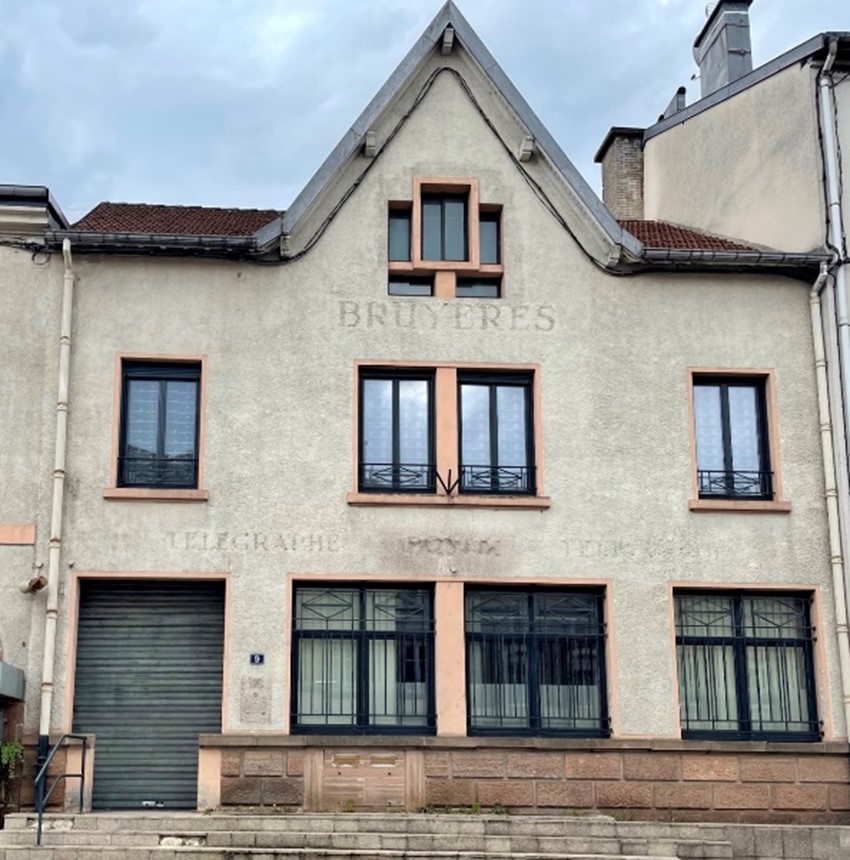
Anne Bonjean will serve as the “President” of the organization. The members of the oversight group will include Martial Hilaire, President of the Peace and Freedom Trail organization, Benoit Howson, professor at the Hubert Curien Technical Institute (University of Lorraine) and perhaps Denis Henry, the mayor of Biffontaine.
The current mayor of Bruyères will provide the floor plan of the existing Treasury Building from which an architect can begin the process of laying out the museum’s layout based on requirements and specifications that we have provided.
Two issues must be resolved. First the funding for the modifications. These changes to the building will be paid for entirely by donations to our 501 (c) (3) that have and will be gathered from doners. We are again seeking donations and book sales to complete the estimated $125,000 needed to prepare the building. Anne Bonjean believes that perhaps some additional funding might be available from the “French Administration,” although France’s economy is struggling.
The second issue relates to the ongoing operation of the museum and the associated cost. Anne will negotiate with the Mayor of Bruyères, the Peace and Freedom Trail Association, and the Tourist Bureau for staffing commitments that will guarantee the opening and ongoing operations.
Those interested in contributing may go to the Heroes of the Vosges Museum Fund at vosgesheroes.org or scan the following QR Code:

Our Nation’s Promise
Los Angeles, California
Written by Robert M. Horsting, Author and Oral Historian
For those military service members who have been deployed to combat zones, actively served on the front lines or in support of those troops, witnessed the “collateral damage” to the civilian population, experienced the loss of a friend, or more directly, experienced the trauma of a physical injury, being brought back to American soil has only been part of the long journey. Making it all the way home has proven to be a greater challenge as they deal with Post-Traumatic Stress Disorder (PTSD).
The American Psychiatric Association (APA) defines PTSD as “a psychiatric condition that may occur in people who have experienced or witnessed a traumatic event or series of traumatic events. The individual often experiences the event or events as emotionally or physically harmful or life-threatening.”
Per a History.com article titled PTSD and Shell Shock, ancient literature acknowledges references to symptoms of emotional trauma experienced by soldiers in battle. In the “Epic of Gilgamesh,” dating back to 2100 BCE, having witnessed the death of his closest friend, the main character experienced “recurrent and intrusive recollections and nightmares related to the event.” In his account of the battle of Marathon, the Greek historian Herodotus described the sudden blindness experienced by a soldier who saw a comrade die. It was referred to as being brought about by fright as opposed to a physical wound, and the condition lasted many years.
The term “nostalgia,” coined by Swiss physician Dr. Johannes Hofer in the late 1600s, described soldiers displaying symptoms of sleeplessness and anxiety, and suffering from homesickness and despair. During that period, doctors of other European nations noted similar observations. In the mid-1700s, broadening the scope of the nostalgia diagnoses, Austrian physician Josef Leopold Auenbrugger observed, “Soldiers became listless and solitary, among other things, and efforts could do little to help them out of their torpor.”
The History.com article states that “Nostalgia was a phenomenon noted throughout Europe and the ‘disease’ reached American soil during the U.S. Civil War (1861–1865).” Although nostalgia was commonly adopted as a medical diagnosis, some military doctors made the assessment, “…the illness as a sign of weakness and one that only affected men with a ‘feeble will’—and public ridicule was sometimes the recommended “cure” for nostalgia.” This approach was prominently highlighted in a scene from the film “Patton” where the general saw a soldier sitting in the medical aid station with no apparent physical wound, slapped the soldier’s helmet, adding some choice words to snap him out of his stupor and get him back on the frontline.
In subsequent wars, the terms for the condition have transitioned from “shell shock” during WWI, to “battle or combat fatigue.” Unfortunately, that stigma associated with it has not only impacted the military response in treating PTSD, but more importantly, the willingness of active military service members and retired personnel to admit they are experiencing PTSD symptoms, let alone actively seeking help for the condition which they are experiencing, and in many cases, the fallout of which they’re subjecting their loved ones to.
Filmmaker David Brodie’s documentary, “The Volunteer,” provides a complex and at times, a disturbing insight into the internal struggle of Bruce Nakashima, a Vietnam veteran. Serving as the only Asian American in his frontline unit contributed to his PTSD challenge, which included being mistaken for the enemy and a near-death experience. The “moral injury” of harming people who looked like him resulted in a deep-seated shame that caused him to isolate himself from his community at home. Driving that point, Nakashima mentioned meeting a little girl and sharing some canned peaches with her, saying, “She reminded me of my little cousin Linda.” For all veterans, I encourage you to seek out this film in the hope that it will help you to find a way in which you might share your own untold story. This is also a “must-see” for the families of veterans, as a means of providing a glimpse into and a better understanding of the complexities and inner conflict their loved ones might be facing.
To illustrate another example of how a shared experience can create a cathartic moment of all involved, I offer the following story excerpted from “The Go For Broke Spirit: Portraits of Courage,” which I co-authored with Photographer Shane Sato. It features portraits and personal stories of WWII Nisei veterans.
James Ogawa
Born: October 25, 1923, Los Angeles, California
C Company, 100th Battalion, 442nd Regimental Combat Team, US Army
“Like most Nisei vets I’ve spoken to, James has seen his share of violence. He’s been shot at, seen the death of people he knew, and even suffered from frostbite during the approach of the “Lost Battalion” rescue. True to his nature, these aren’t stories he shares often or easily; for that matter, most of these vets don’t speak about themselves. However, there was this one night after returning home from a wedding, when he gave both his children and wife a wonderful gift when he shared the stories of his wartime experience and the brutality he witnessed. He learned the value of life, having seen it taken away from so many young men. Even as the hours passed, and at times his words drove them to tears, they recognized the value of this opportunity, and no one interrupted or moved until he said all he needed to…. In this way, I think they returned the gift. When I think of how cathartic this must have been for James and his family, I wish that all veterans and their families could share a moment like this, to grow closer and really understand the sacrifice and pain being held inside. I hope those vets still with us won’t keep their stories inside and their children don’t assume they’ll never share, because I can’t remember how many times I’ve heard vets say, “They don’t ask.” And their children say, “They don’t talk.” The window of opportunity is closing, so if not now, when?”
Though we traditionally associate PTSD with military service members in combat, more recent research has shown that civilians, including young children, subjected to or experiencing traumatic events, have also endured the symptoms. Survivors and First Responders to the 9/11 attacks on U.S. soil, civilians experiencing the sudden loss of family or friends during the COVID-19 pandemic and unable to physically join them in their final hours due to isolation concerns, survivors of natural disasters such as hurricanes, flooding, and wildfires, or traumatic accidents, sexual assault or hate crimes are all people now recognized as potentially experiencing and requiring treatment for PTSD. LaShelle Burch, a Licensed Clinical Social Worker with the VA, feels the recognition that this condition can affect anyone of any age, culture, or ethnicity has reduced the stigma to some degree. Yet, there are still hurdles to clear among each of these groups.
A bigger challenge in these times is access to mental health services. The VA has traditionally been understaffed, facing a huge backlog for veterans requiring immediate access to these resources. Coming out of our nation’s longest continuous combat engagement, these challenges have compounded. In a 2023 USO.org article by Danielle DeSimone, she quotes statistics from a 2021 research paper produced by the Watson Institute For International and Public Affairs, stating that “30,177 active duty personnel and veterans who served in the military after 9/11 have died by suicide – compared to the 7,057 service members killed in combat in those same 20 years.“ For anyone experiencing this level of emotional distress and needing to speak with someone please reach out to the CRISIS LINE: Dial 988, then press 1 or Text: 838255.
We all need to work harder by contacting our elected officials to ensure we meet our obligation and our nation’s promise to bring our veterans “all the way home” with the same sense of dedication they demonstrated in our service.”
Sources include:
1) History.com article titled “PTSD and Shell Shock”
(https://www.history.com/articles/history-of-ptsd-and-shell-shock)
2) The American Psychiatric Association (https://www.psychiatry.org/patients-families/ptsd)
3) David Brodie’s documentary, “The Volunteer” (https://www.volunteerdocumentary.com/)
4) Photographer Shane Sato’s book “The Go For Broke Spirit: Portraits of Courage” (https://www.thegoforbrokespirit.com/)
5) LaShelle Burch – MSW, LCSW – Community Based Interventions for Suicide Prevention Program
(https://www.va.gov/palo-alto-health-care/health-services/suicide-prevention/)
6) USO.org article titled “Concerns Rise Over Military Suicide Rates; Here’s How the USO is Trying to Help,” by Danielle DeSimone
(https://www.uso.org/stories/2664-military-suicide-rates-are-at-an-all-time-high-heres-how-were-trying-to-help)
7) Watson Institute For International and Public Affairs, “High Suicide Rates among United States Service Members and Veterans of the Post-9/11 Wars” (https://watson.brown.edu/costsofwar/papers/2021/SuicidesVETERANS)
8) CRISIS LINE: Dial 988, then press 1 or Text: 838255 (https://www.veteranscrisisline.net/)
A Story of Service and Sacrifice
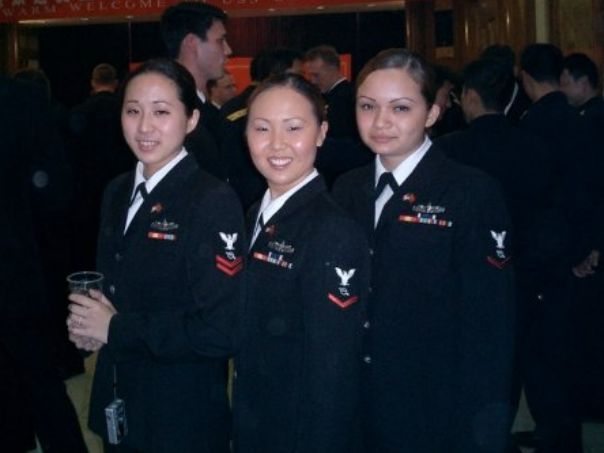
Temecula, California
Written by Mayumi Kimura, LCSW, CalVet Deputy Secretary Women Veterans Affairs
Growing up in California, my childhood wasn’t marked by a struggle to understand my American identity, but more by a persistent sense of just not quite fitting in. Even in California’s diversity, I often felt like I was navigating a space where I didn’t fully connect, either feeling like the only Nisei around or not quite aligning with the experiences of other Japanese kids. Those childhood summers spent in Japan offered a different feeling, a deeper sense of belonging that made returning home often bittersweet, carrying that quiet ache of not fully feeling at ease. My parents worked hard, sometimes holding down two jobs, and my brother and I were truly latchkey kids, leading to my fair share of trouble and a disinterest in school that eventually led to me dropping out in the 10th grade.
Returning to an alternative high school in 11th grade became a turning point, a smaller environment where I felt seen and less judged, which motivated me to graduate. After graduation, college didn’t appeal to me. It was almost on a whim, after hearing about a friend in the Navy, that I decided to enlist.

Looking back honestly, my decision to join the Navy three weeks after 9/11, on September 27, 2001, wasn’t some grand patriotic gesture; it was an escape. I felt like my life was going nowhere, and the military offered a direction, a structure I desperately needed. It was the most impactful and positive decision I could have made. It’s important to acknowledge that my understanding and deep appreciation for the 442nd Regimental Combat Team developed later in my life.
During my initial years in the Navy as an Operations Specialist, my focus was on my duties and navigating military life. The historical context of Japanese Americans serving in WWII wasn’t at the forefront of my mind. However, as I mature and reflect on my journey, particularly my ability, as a Japanese American woman, to serve honorably in the U.S. military, the story of the Nisei who formed the 442nd began to resonate with a profound significance. Knowing their history, I am eternally grateful for their sacrifices.
Despite the tremendous cultural and racial prejudices they faced, and the fact that over 100,000 West Coast residents of Japanese descent were placed in incarceration camps following Executive Order 9066, they still felt the desire to serve their country. This willingness to defend a nation that had unjustly incarcerated their families set a powerful precedent. Their formation as a segregated unit in February 1943, their “Go For Broke” motto – inspired by Hawaiian gambling lingo, meaning to risk it all in one effort to win big – and their subsequent actions in Italy, southern France, and Germany now feel deeply foundational to my own journey. It took time to fully grasp the parallels between their fight for recognition and my own quiet struggles with belonging. Their unwavering loyalty to the United States during World War II, even while their rights were denied, paved the way for future generations. Their courage in the face of such immense injustice made it possible for someone like me to enlist and serve without facing the same level of systemic questioning of my loyalty based solely on my heritage.
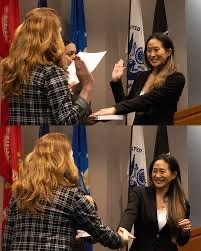
In my post-military career, transitioning to civilian life involved a dedicated pursuit of supporting fellow veterans. This led me to become a Licensed Clinical Social Worker (LCSW). My experience included serving as Director of the Housing Unit for Military Veterans (HUMV), a specialized treatment unit for incarcerated veterans, and as a Vet Center Readjustment Counselor, providing specialized mental health treatment for some of the most severe presentations of Post-traumatic Stress Disorder. Subsequently, driven by a commitment to address the specific needs of those who have served, I founded my own PTSD and trauma therapy practices for veterans and first responders. Throughout these roles, the 442nd commitment to “never leave a cut-off individual or unit” – powerfully exemplified by their heroic rescue of the “Lost Battalion” in the Vosges Mountains – became a profound guiding principle in my work.
Today, I serve as the Deputy Secretary of Women Veterans Affairs at the California Department of Veterans Affairs. I deeply recognize that the 442nd’s relentless fight against immense prejudice at home while demonstrating unparalleled valor abroad contributed significantly to the gradual crumbling of racial discrimination. The eventual recognition of their extraordinary service and sacrifice through the Civil Liberties Act of 1988 and the awarding of the Congressional Gold Medal in 2011 underscores the enduring significance of their legacy, a legacy that continues to inspire my dedication to those who have served our nation. Looking back, I see that the story of the 442nd and the broader Japanese American experience during WWII has always been a silent foundation beneath my own path. Their resilience, their choice to serve despite injustice, and their ultimate success in proving their loyalty created a space, however fraught, for subsequent generations of Japanese Americans to contribute to this nation. My ability to serve honorably, and to dedicate my career to supporting fellow veterans, is a debt I owe to their courageous “Go For Broke” spirit, a spirit that, though I came to understand it later, has been an undeniable force in shaping my life.
Nisei Family Legacy
Seattle, Washington
Written by 2LT TJ Okamura, U.S. Army Reserve
Legacy…
The United States rounded up my grandfather in 1942, first to Puyallup Fair Grounds, then Minidoka. He volunteered for the 442nd from the camps and served in Europe for the next two years. His story isn’t unique among many Nikkei. At least 14,000 others chose the same for a chance to prove their loyalty when they did not need to. They went for broke – not just in battle, but in staking everything on the hope that their service would prove they belonged, that they were undeniably American.
I have carried this with me. It is what influenced my own decision to first enlist and later commission into the United States Army. It is what drives me to give it my all to accomplish my goals. To me, the struggles our grandfathers and great-grandfathers endured and the efforts to overcome them embodied their gaman spirit. What I face is so much smaller in scale; how could I ever live up to what they lived through?
We should remember this legacy. Those who came before us suffered through it, so we, as their descendants, would not have to. That I must go for broke to defend their legacy, to ensure no one else experiences the same again, for looking like the “enemy.”
We should remember this legacy because many others do not, and are willing to allow it to happen again, to other Americans.
I am the grandson of Private First Class George Okamura, G Company, 2nd Battalion, 442nd Regimental Combat Team, and I carry his legacy to remind myself of the opportunities given to me and ensure others have the chance too. Their service challenged a nation’s prejudice. Their legacy demands we never forget – and never allow it to happen again.
82nd Anniversary of the formation of the 442nd Regimental Combat Team
Fort Shafter, Hawaiʻi
Written by LTJG Daniel Wong, U.S. Navy Reserve
On March 29th, 2025, Fort Shafter organizations, distinguished guests and attendees gathered to celebrate and honor the 82nd Anniversary of the formation of the 442nd Regimental Combat Team (RCT). The banquet honored Dr Takashi Manago (100th Bn, 442nd), Tadao Yoshimoto (2nd Bn, 442nd), and Mrs. Muriel Kashiwa [Widow of Genro Kashiwa (3rd Bn, 442nd)]. Consul General Yoshinori Kodoma from the Consulate of Japan in Honolulu was present to pay his respects to the unit and the recent anniversary of the Battle of Iwo Jima, to remember veterans from World War II. U.S. Army Soldiers from the 100th Infantry Battalion, 442nd Infantry Regiment, at Fort Shafter presented the colors. Presidents, members, family, and friends of the 100th Battalion Clubhouse, 442nd Club House, 442nd Legacy Center, Sons and Daughters of the 442nd RCT, and Military Intelligence Service Club were in attendance, too. The main theme of the banquet was legacy and how all organizations can honor those who are currently preserving the “Sekinin” or responsibility as the next generation, which bears the torch for past, present, and future Japanese and Asian Americans.
To honor V-E Day, it was my privilege to meet Dr. Takashi “Taka” Manago, who joined the 100th Battalion and 442nd RCT in Southern France right before the Po Valley Campaign. He recalls assisting stretcher details to carry the wounded and dead after/during battles. After V-E Day, Dr. Manago reenlisted on December 31, 1946 (Leghorn, Italy). Part of his post-war duties was guarding German soldiers (Morita).
Walking proudly with his cane at the banquet was Tadao Yoshimoto, who was assigned to the 442nd RCT as a replacement for E Company, 2nd Battalion. Early during the Po Valley Campaign, Pvt Yoshimura was wounded by artillery shrapnel and lost his left eye. “Before he was taken to the aid station, the soldier who was bandaging his wound was himself hit in the forehead by shrapnel and killed instantly. Yoshimoto was sent back to Hawaiʻi that month and later discharged.” (SD 442 RCT).
At the end of the campaign, most veterans from the 100th and 442nd can recall VE Day as a day of “Gambaru” or perseverance from surviving the war. T/Sgt. Walter Tamotsu Okumoto, known as Joe, of I Company, recalled: “On V-E Day…no one jumped around or celebrated or even yippeed…. We just sat on our helmets without a word, each deep in his thoughts. It was hard to lose buddies with whom we had trained and had become so attached to; our bond to each other was as great as that of blood brothers. Their deaths were and still are hard to accept.” I recall the end of my first deployment; my moment of relief was shrouded in honoring the dedication to my shipmates who shared hardships and tribulations that cannot be explained at home. I tell my story to preserve the memory of those who fallen in the line of duty. I choose to honor the Nisei by sharing our stories.
Dr. Takashi “Taka” Manago, awardee of: European-African-Middle Eastern (EAME) Campaign Medal. World War II Victory Medal. Army World War II Occupation Medal with Germany clasp. Honorable Service lapel button – World War II.
Private Tadao Yoshimoto was awarded the Bronze Star Medal, Purple Heart Medal, Good Conduct Medal, Asiatic-Pacific Campaign Medal, European-African-Middle Eastern Campaign Medal with one bronze star, World War II Victory Medal, Distinguished Unit Badge, and Combat Infantryman Badge.
Both Dr. Manago and Mr. Yoshimoto were awarded the Congressional Gold Medal along with the other veterans of the 100th/442nd Regimental Combat Team.
Sources:
- Morita, Jeff. “Dr Tadao Manago Military Service Timeline Presentation (OMPF).” 2024.
- “Soldier Story: Tadao Yoshimoto.” Edited by Sons and Daughters of the 442nd, Sons and Daughters of the 442nd Regimental Combat Team, Sons and Daughters of the 442nd, 26 Mar. 2022, 442sd.org/learn/soldier/tadao-yoshimoto/
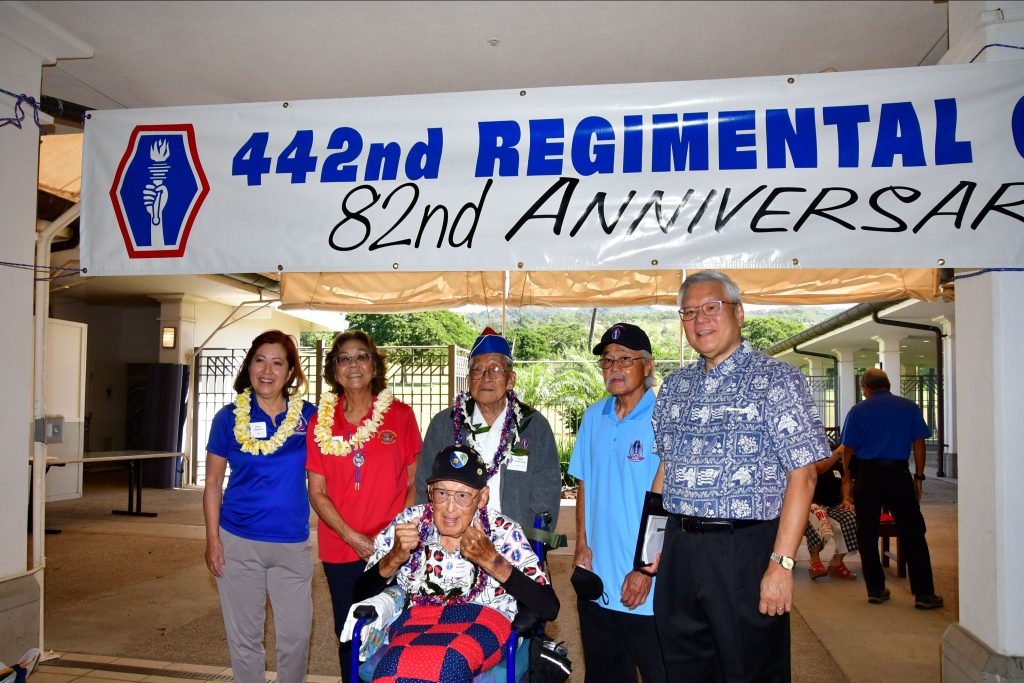
“One Puka Puka Leads the Way” Musical Tribute to the 100th Infantry Battalion
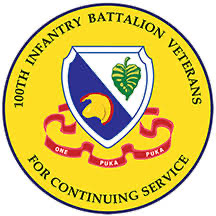
Honolulu, Hawaiʻi
Written by Kathi Hayashi, 100th IBV President and Education Chair and Amy Kwong, 100th IBV Board Director and 100th IBV Communications Chair
Much appreciation to Howard High, President of the Japanese American Veterans Association (JAVA) for creating the lyrics and composition to a moving musical tribute to the 100th Infantry Battalion soldiers, titled “One Puka Puka Leads the Way.” The 100th Infantry Battalion Veterans organization, also known as Club 100, added a montage of photos of the 100th soldiers to the tribute. Many at Club 100 were moved to tears by the poetic and soulful lyrical description of the arduous battle that our 100th patriarchs endured in combat and in America’s view of people of Japanese ancestry after the attack on Pearl Harbor. Then, tears of appreciation that the President of venerate JAVA would invest so much time to honor the 100th Infantry Battalion soldiers in such a precious way. It is difficult to describe the overwhelming gratitude felt, hearing the 100th Infantry Battalion validated and recognized by the President of one of the most revered Japanese American Veterans organizations in our country. We are humbled. Mahalo.
Video by Club 100 with song from JAVA President Howard High.
“One Puka Puka Leads the Way,” honors the extraordinary courage, sacrifice, and legacy of the 100th Infantry Battalion — a unit formed primarily of Japanese American soldiers from Hawaiʻi during World War II. This battalion was the first Japanese American segregated unit in the U.S. Army, composed almost entirely of “Nisei” (Japanese Americans born to first generation “Issei” immigrant parents), and emerged as one of the most decorated units in American military history. The battalion is known affectionately by its nickname, “One Puka Puka” (“puka” means “hole” in Hawaiian, and the zero resembles a hole).
The song is more than a tribute — it is a lyrical chronicle of identity, duty, and unwavering loyalty. At the time of the Pearl Harbor attack in December 1941, many of the men who would become part of the 100th Infantry Battalion had already been drafted and were serving in the activated Hawaiʻi National Guard units, specifically the 298th and 299th Infantry Regiments under U.S. Army command in Hawaiʻi. The Americans of Japanese ancestry (AJA) continued to serve in these units until May 1942, when they were segregated into a separate battalion, leaving the islands in secrecy on June 5, 1942. Named the “100th Infantry Battalion (Separate), the men underwent training at Camp McCoy, Wisconsin, and Camp Shelby, Mississippi, before deploying to the European-African-Middle Eastern (EAME) Campaign theater on August 21, 1943.
The 100th headed into combat at Salerno in southern Italy on the night of September 26, 1943. On September 29, the unit engaged in active combat for the first time, and the men were hit hard when the first in the unit was killed in action — SGT Shigeo Joseph “Joe” Takata. The high rate of casualties the 100th Infantry Battalion (Sep) suffered during its first five months in combat, including the Battle of Monte Cassino, would earn it the moniker of “The Purple Heart Battalion.”
Through the battle-scarred hills and flats of Italy and France, the lyrics carry listeners through the emotional and physical journey of these soldiers. The song reflects the deep struggle against prejudice that shaped their experience, echoing themes of “gaman” (quiet, steadfast endurance), honor, and the powerful message of “ganbare” (persevere, no matter what) found in letters received by the 100th from their parents. In the wake of the attack on Pearl Harbor, these messages from the Issei urged their sons to demonstrate loyalty and fight for America, not Japan.
The lyrics reinforce the battalion’s role as a leader — breaking barriers and proving, through valor, their devotion to the United States even when their loyalty was unjustly questioned. The outstanding training record of the 100th Infantry Battalion (Sep) in 1942, led to the formation of the 442nd Regimental Combat Team (RCT) in 1943. The valor of the 100th in its first weeks of fighting in Italy, convinced the War Department that American soldiers of Japanese descent could be trusted in combat, thus clearing the way for the 442nd RCT to join the 100th Inf Bn in Italy, in June 1944. The song reflects not just their contributions during the war, but also the postwar accomplishments of these veterans as they returned home to become leaders in civic life, championing justice and equality.
The men of the 100th Infantry Battalion carried the people of Hawaiʻi in their hearts throughout the war, proudly bearing the unit’s motto of “Remember Pearl Harbor,” and a unit coat of arms inspired by the Hawaiʻi National Guard units they once served in. The men embodied the concept of “inclusion” and spirit of unity, present in their homeland of Hawaiʻi, that embraced all people regardless of color. The 100th Infantry Battalion, though composed primarily of AJA, was led by a Caucasian commander, Lt. Col. Farrant Turner, who deeply loved and respected his men, handpicking his Caucasian officers to build a strong, unified team. The unit also included a few Native Hawaiian, Korean, and other soldiers of mixed or no Japanese ancestry, who joined the unit at the time of its formation, because of the powerful bonds they shared.
Although the 100th Infantry Battalion (Separate) soldiers led the way, they must have sighed in relief, that the blood of the 100th spilled from death and wounds were not shed in vain. The young men of the 442nd RCT would “carry on” the mission that the 100th started. The 100th arrived in Salerno, Italy on September 22, 1943, with 1,300 men. After fiercely fighting the Nazi with superior positions on the hills, by the end of February 1944, just 5 months later, the unit was down to 460 men able to fight. On August 10, 1944, the 100th Infantry Battalion (Separate) was reassigned to serve as the 442nd’s 1st Battalion, but allowed to keep the 100th Battalion name due to its stellar training and combat record. The 100th and 442nd RCT would become the most decorated in U.S. military history for its size and length of service.
Our patriarchs were brothers in battle, and we are now brothers and sisters to share the legacy and values they left with us. With AJA veterans organizations and the community “locking arms,” we work together as stewards of the nisei warriors’ legacy. We pledge that no one will ever erase from history what these great Americans did for Hawaiʻi, America and the world.
With solemn respect and poetic grace, “One Puka Puka Leads the Way” stands as a musical tribute to a group of Americans who changed the course of history — fighting not only for victory abroad, but for dignity and recognition at home. Mahalo with revered gratitude to President Howard High and JAVA for the musical tribute and the special edition newsletters honoring V-E Day.
Upcoming JAVA Events

Saturday, June 28, 3:00 PM EDT. 17th Annual JAVA Memorial Scholarship Awards Ceremony. Facebook Live.
Tuesday, July 15, 9:00 AM EDT. 6th Annual Day of Affirmation Ceremony, WWII Memorial, Washington, D.C. Luncheon to follow at The Army and Navy Club, 901 Seventeenth St, NW, Washington, D.C., 20006.

